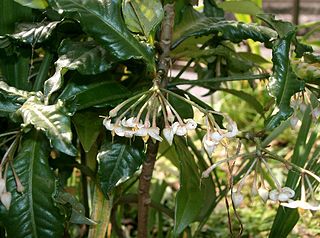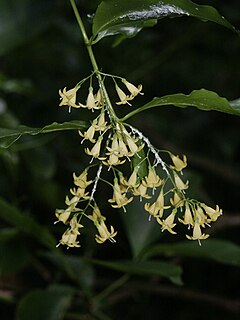
The Primulaceae, commonly known as the primrose family, are a family of herbaceous and woody flowering plants including some favourite garden plants and wildflowers. Most are perennial though some species, such as scarlet pimpernel, are annuals.

Manilkara zapota, commonly known as sapodilla, sapota, chikoo, chico, naseberry, or nispero is a long-lived, evergreen tree native to southern Mexico, Central America and the Caribbean. An example natural occurrence is in coastal Yucatán in the Petenes mangroves ecoregion, where it is a subdominant plant species. It was introduced to the Philippines during Spanish colonization. It is grown in large quantities in India, Pakistan, Thailand, Malaysia, Cambodia, Indonesia, Vietnam, Bangladesh and Mexico.

Myrica is a genus of about 35–50 species of small trees and shrubs in the family Myricaceae, order Fagales. The genus has a wide distribution, including Africa, Asia, Europe, North America and South America, and missing only from Australia. Some botanists split the genus into two genera on the basis of the catkin and fruit structure, restricting Myrica to a few species, and treating the others in Morella.

Sebastiania is a genus of flowering plants in the family Euphorbiaceae first described in 1821. It is native to North and South America from Arizona and the West Indies south to Uruguay.

Calyptranthes is a genus of flowering plants in the family Myrtaceae. They are known commonly as lidflowers, spicewoods, and mountainbays. There are about 100 species.

Myrciaria is a genus of large shrubs and small trees described as a genus in 1856. It is native to Central and South America, Mexico, and the West Indies, with many of the species endemic to Brazil. Common names include hivapuru, sabará, and ybapuru.

Schoepfia is a genus of flowering plants belonging to the family Schoepfiaceae. The genus has long been placed in the Olacaceae family though many researchers noted the differences between it and the rest of the family. Recent molecular studies have shown Schoepfia to be more closely related to the families Misodendraceae and Loranthaceae, and to uphold the criteria of monophyly it must be excluded from Olacaceae.

Ardisia is a genus of flowering plants in the family Primulaceae. It was in the former Myrsinaceae family now recognised as the myrsine sub-family Myrsinoideae. They are distributed in the Americas, Asia, Australia, and the Pacific Islands, mainly in the tropics. There are over 700 accepted species. One species, Ardisia japonica is one of the 50 fundamental herbs in traditional Chinese medicine.
Geissanthus is a genus of shrubs and trees in the family Primulaceae. There are 51 species distributed in South America, with 25 of them in forests of the Andes.

Parathesis is a genus of flowering plants in the family Primulaceae. There are about 95 species distributed from Mexico to South America and the Caribbean. Plants of this genus can be distinguished by glandular papillae on the lobes of the flower corolla and bright yellow anthers.
Stylogyne is a genus of shrubs and trees in the family Primulaceae. Its members are found throughout tropical parts of the Americas, with the greatest diversity in South America. It is closely related to the genera Ardisia and Geissanthus, and various species have been transferred between the three genera. All three were formerly placed in the family Myrsinaceae, which is now treated as a subfamily (Myrsinoideae) of the Primulaceae.

Myrsine is a genus of flowering plants in the family Primulaceae. It was formerly placed in the family Myrsinaceae before this was merged into the Primulaceae. It is found nearly worldwide, primarily in tropical and subtropical areas. It contains about 200 species, including several notable radiations, such as the matipo of New Zealand and the kōlea of Hawaiʻi. In the United States, members of this genus are known as colicwood. Some species, especially M. africana, are grown as ornamental shrubs.

Chiococca is a genus of flowering plants in the family Rubiaceae. It currently holds 23 species that are native to Florida, Texas, Mexico, Central America, much of South America, the West Indies, and the islands of Galápagos and Fernando de Noronha.

Crossopetalum, commonly known as Christmas-berries or maiden berries, is a genus of flowering plants in the family Celastraceae. It comprises about 30-40 species.
John James Pipoly III is an American botanist and plant collector. He is a leading expert on the systematics and taxonomy of the genus Ardisia within the Myrsinoideae, as well as the family Clusiaceae.
Ctenardisia is a genus of flowering plants belonging to the family Primulaceae.
Discocalyx is a genus of flowering plants belonging to the family Primulaceae.
Matayba is a genus of flowering plants belonging to the family Sapindaceae.











